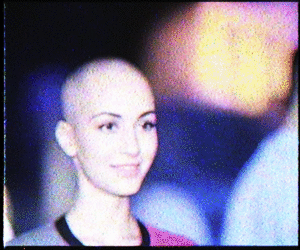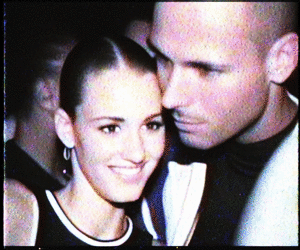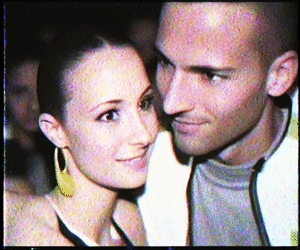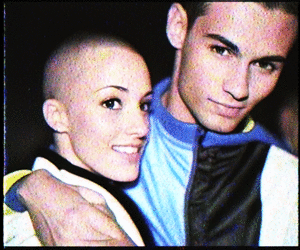Hayden Martin: current thoughts, images and the point of working
Hayden Martin is a digital artist and director based in London. Specializing in music videos, fashion films and high-end content production, he has created work with brands such as On Running, Puma, Nike, Formula One, Sony Music and many more. His unique approach to cutting-edge digital technologies such as neural networks and 3D scanning, paired with his analogue sensibility for imagery, allow him to create visuals that are unlike anything else produced in the field.
We spoke to him about his process, the pleasure of creative constraints, and the perfect balance between art and technology.
INTERVIEW Nele Jackson & Jeanne-Salomé Rochat

Which aspects of your work do you enjoy the most?
I don’t want work to feel like work, if that makes sense. I am most drawn to projects that allow me to be immersed in exploration and discovery. My personal passion lies in the intersection of technology and nature, which I try to bring into my professional life as much as possible.
I’ve always felt very comfortable being engrossed in technical problem-solving, research and design. The majority of what I read in my spare time are white papers on developments in optics, simulation, neural networks and real-time graphics. I find it all very fascinating, so when I have the opportunity to apply these areas of knowledge in my work it feels very natural and fun. I prioritize projects that include travel though. Getting away from the screen and being a nerd out in nature is super important to me. At the moment, I’m very into scanning large areas with drones and LiDAR*. I find the idea of digitally immortalizing stuff very romantic, so these days I’m finding excuses to do these types of digital surveying jobs more frequently…
*a 3D laser scanning technique, short for ‘Light imaging, Detection And Ranging’
I find the idea of digitally immortalizing stuff very romantic.
You work on personal creative projects as well as on commission for big clients like Puma, Nike or Apple. Do you think of your work as art?
Hard to say. I definitely started out with the vision of being a video artist. I wanted to be Chris Cunningham. In many ways I still do. I respect his work a lot, and I wish he’d re-emerge. His path really inspires me – how he went from a background in robotics and prosthetics to directing incredible video work. I went to film school to learn all about cinematography, lighting, editing, composition, and so on, after being inspired by his work. That being said though, I don’t know if I have the capacity to handle the art world, at least not right now. I’m not a huge fan of how video art is typically shown and shared… It's a weird medium. The allure of video art is certainly there, but I'm more inclined towards experiencing art in its most tangible, physical form, like sculpture. That said, I am comfortable with people interpreting my work in their own way, be it art or otherwise. The most important thing for me is to keep exploring and creating, particularly in relation to nature.
Do you prefer to stick to one general approach when working, or do you like to switch up your methods?
I’m easily distracted but I also get hyper-fixated. I’m very obsessive when it comes to certain techniques. Two years ago, I was absolutely obsessed with VFX simulations – creating realistic smoke, fire, water, particles, debris, et cetera. Now I’m far more interested in what I mentioned earlier – digitizing real environments through photogrammetry, neural radiance fields, LiDAR, motion capture, and 360° cameras.
My love for exploration extends to my method of work as well. Being on-set and on-location, immersing myself in the environment, and experimenting with different cameras and rigs to achieve a certain look or feel is what truly excites me.
Are there any constraints you find helpful when developing ideas?
Nearly all of my most successful work was made with me being incredibly constrained either by time, budget, or both. I do find that being forced to adapt to certain limits can really purify your audiovisual language. That doesn’t mean that I want to work under pressure all the time though.
I’ve made great work in more casual collaborations with people I genuinely admire. As long as I’m on the same page with who I’m working with, we’ll make something good. I love designing record sleeves and flyer artwork, for example. When I work on something that I’m really into, I’m usually happy with the result.
I’ve been freelancing for years because I have a hard time falling in love with other people’s creative or professional visions [laughs]. It allows me to pick and choose who I want to work with, which frees me of some constraints.

Does it become easier or harder to create when your work gets a lot of attention?
I’ve never thought about this before. When a project gets a lot of attention I try to let it soak in for a while so I can gauge what was good about it. I don’t want to slip into a formulaic approach of making the same thing over and over again. There’s a lot of that in the motion design community – entire Instagram pages dedicated to “satisfying” animation clips or dancing Marvel characters, and I thoroughly hate it. It’s too easy. At that point, it’s no different from a generic street art print.
Do you ever abandon projects or shelve them for later?
Quite often! I’m very picky about stuff and, as mentioned, I can get hyper-fixated on the minutia of my work. I’ve made a few things in the past that were technically awesome but ended up not really popping on screen, or not feeling very considered. It’s easy to get too focused on the process rather than the end product.
This may seem off-topic, but to me, the best-ever balance between technical and creative accomplishment was achieved by The Matrix and Terminator 2. I like to look for that balance in every work. Is this beautiful, provocative and fresh? Does it have that fun sense of “how did they do that?”. If I feel that the creative and technical side are out of balance in my own work, I often just abandon the project and use it as a lesson.

It feels like there’s a lot of crossover between the worlds of technology and art, but not necessarily a lot of literacy or understanding. What do you think?
I think it really depends on the circles you are in. There’s a few other CGI or VFX-oriented artists and directors I genuinely trust in terms of understanding both worlds and achieving nuanced crossovers. But the majority of 3D or other new technology art out there actually drives me insane. It’s such a male-dominated field, too. It feels like everyone wants to make the next cool 3D army robot render or edgy techwear promo, and it really cannibalizes the aesthetic potential of technology meeting art. I’d say there’s plenty of amazing things that could happen – I love Richard Mosse’ work using hyperspectral cameras, for instance – but overall, tech-oriented art is still very techy [laughs]. If we want to expand artistic and technological literacy, I think we need to get away from the Behance or Artstation vision of technology.
What does the word “avatar” mean to you?
I don’t usually think of typical questions of digital identity or anything like that.
I feel that digital identities in themselves are nothing new.
I’ve been online since I was 8 and I’ve been on so many different social media platforms, chat rooms, forums, game lobbies, et cetera. I’ve never felt the need to craft a digital version of myself. But that’s just me personally and I understand that other people experience online persona development differently. I can certainly see the appeal of having a digital alter ego.
In your mind, what is the ideal relationship between digital and analogue work? How do you bring them together in the most exciting way?
I’ve been thinking about this a lot lately. I’ve started to grow quite tired of the ultra digital look of a lot of content – this sort of “cyber” echochamber of neon and chrome we see so much of on Instagram, or the hyper-detailed biomechanical look that brands like Nike won’t let go of… like the classic FlyKnit advert where a shoe builds out of fibers in an ultra complicated simulation.
It seems to me that big brands absolutely love flexing with the most complex CGI marvels they can afford, but ultimately it feels stale - like it’s literally just a running shoe advert and it will have Hollywood levels of technical animation, simulation and sound design. I remember when the agency Man Vs Machine basically put the Houdini software on the map by using it on countless ads. It was really exciting for a while, but just like trends in fashion grow old, so do trends in CGI. I’m rooting for new mediums to disrupt this pattern and introduce new visual languages, even if they’re very DIY.
I love the work that the people at Service Generaux are putting out. It’s miles ahead of that territory and at times feels very analogue or “lo-fi” which can be amazing if it’s done honestly and with true motivation. I’m also a big fan of Chris Glickman’s work. He knows exactly how and when to pick digital versus analogue techniques.

Apart from 3D-Scanning, are there any other new or upcoming technologies you’re really excited about and would like to delve into?
I’m super into Neural Radiance Fields (NeRF), which I think is the future of digitization and photorealism. It’s a sort of hybrid between traditional photogrammetry and image interpolation that allows for all sorts of creative effects, like entirely changing the way a camera moves through footage you’ve shot, or completely relighting somebody... It’s almost witchcraft, and it’s only in its infancy now. It’s probably going to be built into most of our photo apps and devices within the next few years. And once it begins to snowball, it’s the kind of thing that will massively empower new creatives.
Are there any technological limitations would you really like to see shattered?
I’d like us all to just be entirely cloud-based and green without the need for bulky “in-house” hardware. I often work with render farms where multiple computers are linked up to distribute the load of processing animation, but I think we’re getting closer to an exciting future where everybody can volunteer a personal device to share the load on a colossal scale. Think mass cloud-based rendering, happening in the background on millions of devices at once.
What do you make of the recent explosion of AI-enabled visual and creative technologies? Is it something that you see continuing to fuel or threatening your work in the future?
I’ve been messing with AI for a while, and I find it quite exciting. I’ve had a lot of conversations about this lately, and to be honest I don’t really feel threatened by it.
The key is to just keep learning new things, finding out how emerging software/hardware can be applied or creatively misused, and just accepting that when one door closes another opens.
People are acting like this is the end of painting and art, and so on… I think that’s an unhealthy doomer mentality.
Hayden Martin's recent Thunderdome work involves an AI experiment, recreating the essence of the famous 1997 Thunderdome rave through synthetic club photography. The approach was simple: use a hypernetwork, a form of neural network, to adjust an AI model, creating new visual styles.
Contrary to popular belief, AI doesn't store and replicate images as they are. Instead, it navigates a semantic space encompassing the 'essence' of billions of images. As the AI interacts with this space, it decodes an image aligning with the provided prompts.
The hypernetwork was trained on Thunderdome footage and then applied to the base AI model, the LAION 5B. This process is somewhat analogous to how a Look-Up Table (LUT) alters video footage to create fresh styles. The result was a distinctive blend of past and present, offering a visual experience reminiscent of the '97 famed event. Far from replacing creativity, AI is emerging as a tool for novel expressions in contemporary art.
